
An echinoderm is any member of the phylum Echinodermata. The adults are recognisable by their radial symmetry, and include starfish, brittle stars, sea urchins, sand dollars, and sea cucumbers, as well as the sea lilies or "stone lilies". Adult echinoderms are found on the sea bed at every ocean depth, from the intertidal zone to the abyssal zone. The phylum contains about 7,000 living species, making it the second-largest grouping of deuterostomes, after the chordates. Echinoderms are the largest entirely marine phylum. The first definitive echinoderms appeared near the start of the Cambrian.

Starfish or sea stars are star-shaped echinoderms belonging to the class Asteroidea. Common usage frequently finds these names being also applied to ophiuroids, which are correctly referred to as brittle stars or basket stars. Starfish are also known as asteroids due to being in the class Asteroidea. About 1,900 species of starfish live on the seabed in all the world's oceans, from warm, tropical zones to frigid, polar regions. They are found from the intertidal zone down to abyssal depths, at 6,000 m (20,000 ft) below the surface.
Werner Rauh was a German biologist, botanist and author.

Cephalopholis panamensis, the Pacific graysby or Panama graysby, is a species of marine ray-finned fish, a grouper from the subfamily Epinephelinae which is in the family Serranidae which also includes the anthias and sea basses. It is found in the Eastern Pacific Ocean.

Compsodrillia excentrica is a species of sea snail, a marine gastropod mollusk in the family Pseudomelatomidae, the turrids and allies.
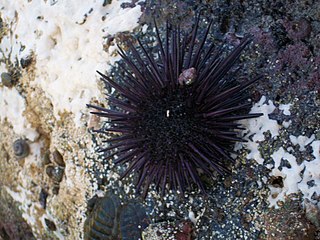
The sea urchins of the Gulf of California live between the coasts of the Baja California Peninsula to the west and mainland state of Sonora, Mexico to the east. The northern boundary is the lateral band of land with the remains of the Colorado River Delta, and the southern is the Pacific Ocean.
Linckia columbiae is a species of starfish in the family Ophidiasteridae. It is found in the East Pacific where it ranges from California (USA) to northwest Peru, including offshore islands such as the Galápagos. Common names include fragile star, Pacific comet sea star and variable sea star.
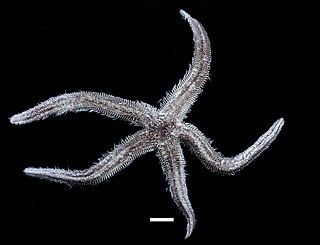
Luidia superba is a tropical species of starfish in the family Luidiidae. A single specimen was found off the Pacific coast of Colombia in 1888; the species has since been found in the Galapagos Islands. It is endemic to this area and has not been recorded elsewhere.

Phataria unifascialis is a species of starfish in the family Ophidiasteridae. It is sometimes known as the blue seastar or tan starfish, but both these names are also used for other species. It is native to the eastern Pacific Ocean where it ranges from the Gulf of California and Magdalena Bay (Mexico) to northwest Peru, including various eastern Pacific island groups such as the Galápagos. It remains fully active at temperatures down to 17 °C (63 °F), but becomes inactive when it drops to 14 °C (57 °F). It reaches a diameter of about 30 cm (1 ft).
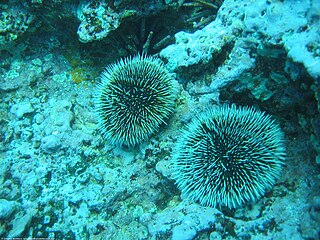
Tripneustes depressus, the white sea urchin or sea egg, is a species of sea urchin in the family Toxopneustidae. It is found on the seabed in the tropical eastern Pacific Ocean including Mexico, Panama, Ecuador and the Galápagos Islands.

Heliaster kubiniji is a species of starfish in the order Forcipulatida. It is commonly known as the gulf sun star, the common sun star or estrella de mar de golfo and it occurs in the intertidal zone of the Pacific coast of California, Mexico and Nicaragua.
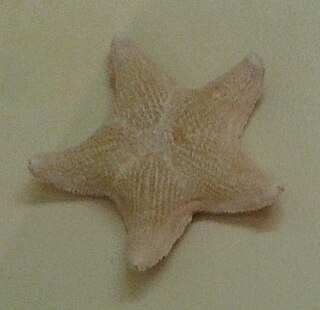
Asterina stellifera is one of thirty species of small bat star in the genus Asterina. It is mainly found on the east coast of South America, ranging from Cabo Frio, Brazil to Mar del Plata, Argentina. In the past decades, their numbers have depleted and are currently abundant only in the southern limit of its former range. Due to this decline, it is on Brazil’s endangered species list. It has a slow growth rate and relatively long lifespan. A. stellifera is an omnivorous generalist predator, and modifies the abundance of other invertebrates and algae in subtidal marine communities.

Neoferdina cumingi, also known as Cuming's sea star, is a species of starfish in the family Goniasteridae. It is native to the tropical Indo-Pacific region.

Echinaster luzonicus, the Luzon sea star, is a species of starfish in the family Echinasteridae, found in shallow parts of the western Indo-Pacific region. It sometimes lives symbiotically with a copepod or a comb jelly, and is prone to shed its arms, which then regenerate into new individuals.

Freyella elegans is a species of deep-water starfish in the family Freyellidae in the order Brisingida, living at abyssal depths in the northwestern Atlantic Ocean.
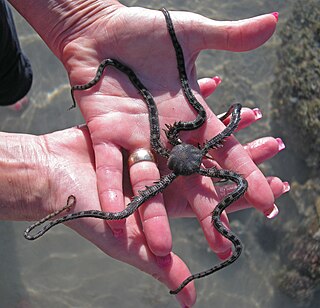
Ophiocomella alexandri, known as Alexander's spiny brittle star or banded brittle star, is a species of marine brittle star. It was first described to science by Theodore Lyman in 1860. Lyman states in his description that the animal is named for his friend, Alexander E. R. Agassiz, the son of Lyman's mentor, Louis Agassiz.

Mithrodia bradleyi, known as Bradley's sea star, is a species of sea star. It was first described to science by Addison Emory Verrill in 1870. It was named after Frank Howe Bradley, who collected, in Panama, the type specimen described by Verrill.
Maureen Elizabeth Downey was an American zoologist who worked for three decades at the Smithsonian National Museum of Natural History. Known as "The Starfish Lady," she was an authority on sea stars and other echinoderms, co-founding the International Echinoderm Conference in 1972. Among her discoveries is Midgardia xandaros, the world's largest starfish.
















